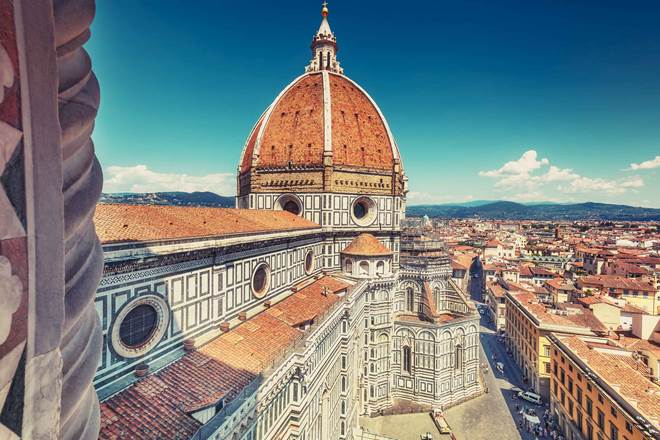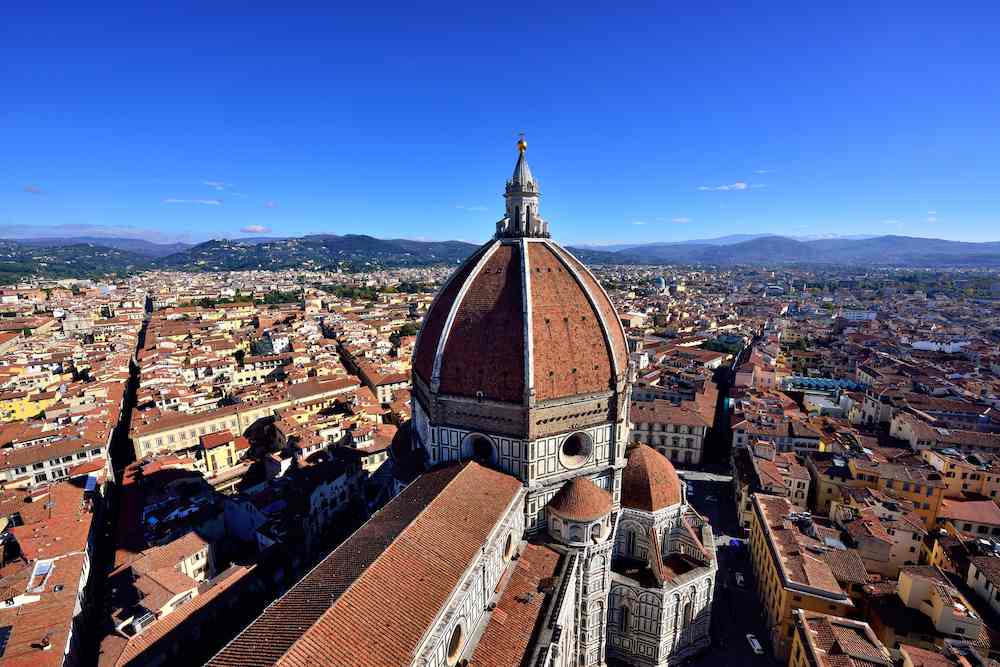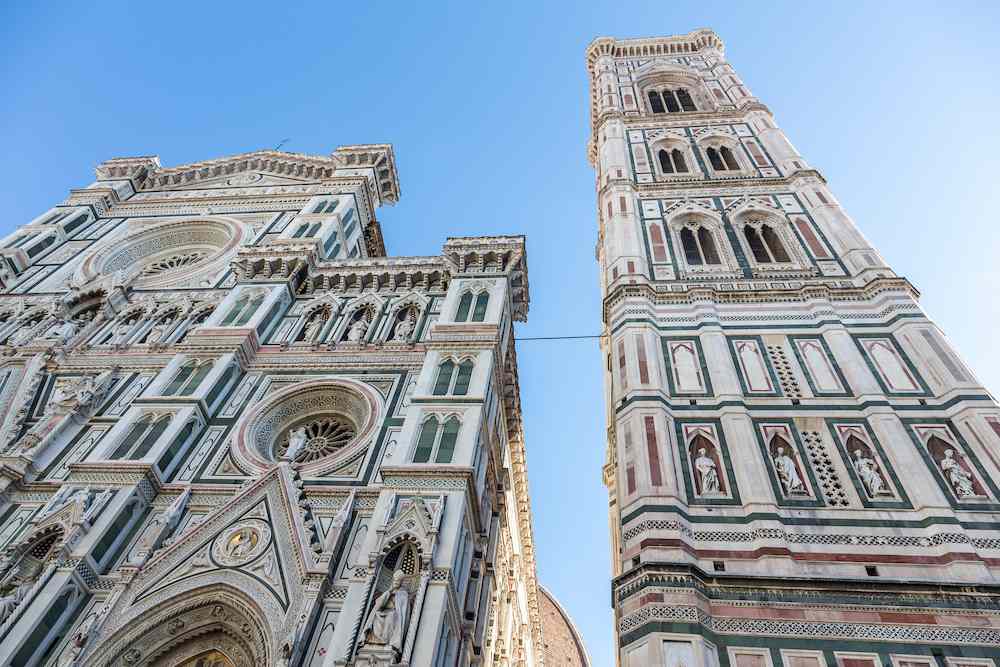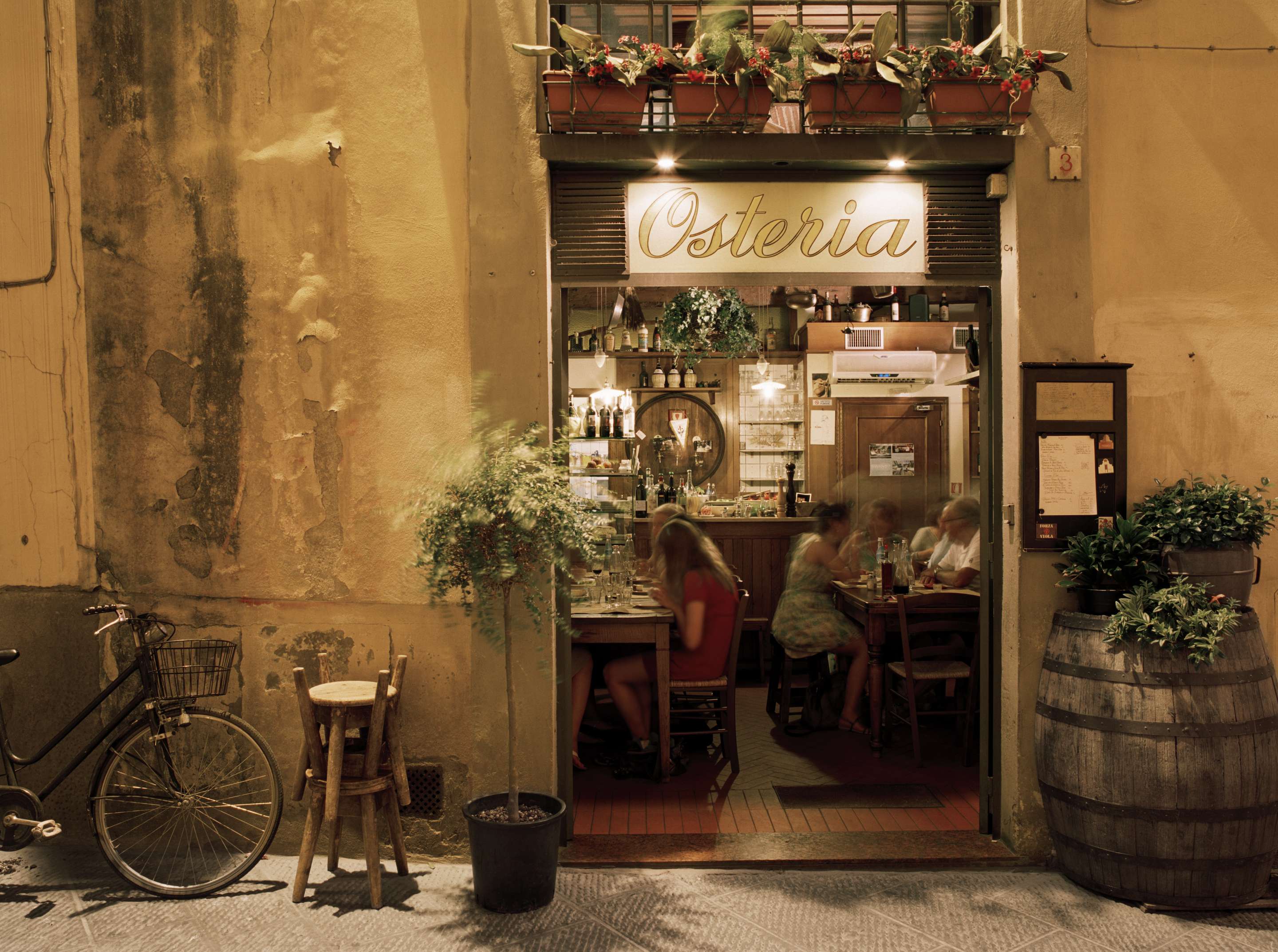A quick internet search of Florence, and one landmark pops up in almost all images. Cattedrale di Santa Maria del Fiore (The Cathedral of Santa Maria del Fiore) is one of the most important buildings in the city and features that iconic dome.
Overlooking the beautiful Piazza del Duomo (Cathedral Square), the Cathedral of Santa Maria del Fiore is home to not just the amazingly intricate dome, but also Giotto’s Bell Tower and Museo dell'Opera del Duomo (The Cathedral’s Museum), which houses the most precious artefacts from the cathedral.
What’s in this guide?
- What to see at the Cathedral of Santa Maria del Fiore
- The Cathedral of Santa Maria del Fiore history and facts
- Restaurants, bars and shops nearby
- Opening times and ticket prices
Getting to the Cathedral of Santa Maria del Fiore
If you’re getting to Florence by train, you’ll just need to get off at Firenze Santa Maria Novella station and walk for about 8 minutes to reach the Cathedral of Santa Maria del Fiore. Alternatively, you can take the bus. Although trams are a great way of getting around the surrounding areas, buses are best for the city centre. For the cathedral, nearby bus stops include Santa Maria Nuova, Picci Duomo, Santa Maria Maggiore and Vecchietti.
When travelling by bus in Florence, you can’t just buy a ticket from the driver, as this will result in a fine. Instead, you’ll need to buy a ticket from an official Autolinee Toscane retailer. If you’re staying for more than two days, we’d recommend purchasing a multiple-ride ticket that includes four 90-minute journeys.
What to see at the Cathedral of Santa Maria del Fiore
At the Cathedral of Santa Maria del Fiore, you’ll find that there are lots of historical sights packed into a small patch of Florence. Here are some stand-out features to look out for when you’re there.
Cathedral exterior
Unfinished until the 19th century, the façade was the last addition to the Cathedral of Santa Maria del Fiore. The colourful blend of red, green and white marble makes a striking impression.
When exploring the exterior, make sure you take in Porta della Mandorla, a figure sculpted by Nanni di Banco that’s surrounded by a large halo. You’ll see two statues of architects Arnolfo di Cambio and Filippo Brunelleschi on the right-hand side.
What’s inside the Cathedral?
Once inside the cathedral, you’ll be wowed by the artwork on show, covering every inch of space. Even the flooring is impressive, which is made up of intricate mosaics. With so much detail included, the floor almost looks like a patchwork of rugs.
Above the entrance, you’ll notice a clock. It may not look as impressive as the surrounding artwork, but the 15th-century clock follows the old Ora Italica time when sunset marked the end of the day. What’s more, it still works!
You can easily be overwhelmed by the amount of artwork within the cathedral, so here’s a quick breakdown of what you should focus on seeing:
- The Last Judgement: This fresco is the most significant artwork in the entire building. Designed by Giorgio Vasari, most of the fresco was painted by his student, Federico Zuccari, and was completed in 1579
- Dante Before the City of Florence: this masterpiece was painted by Domenico di Michelino in 1465, depicting scenes from The Divine Comedy
- The side-by-side 15th-century paintings of heroic figures: The Funerary Monuments to Sir John Hawkwood by Paolo Uccello and the equestrian statue of Niccolò da Tolentino by Andrea del Castagno.
Many original works of art have been moved to Museo dell'Opera del Duomo to protect them from any potential damage. This includes the 1553 Pietà statue by Michelangelo, so it’s definitely worth visiting the museum too.
Also, make sure you take in the exquisite stained glass. Constructed between 1434 and 1455, these were designed by renowned artists including Donatello, Andrea del Castagno and Paolo Uccello.
Brunelleschi’s Dome
The cathedral’s crown, the dome, is a real focal point of this landmark. Filippo Brunelleschi’s stroke of genius is a beautiful example of Renaissance design. Plus, the internal walls have just been restored, so the Final Judgement fresco by Giorgio Vasari will look its best for your visit.
After you climb all 463 steps, take advantage of one of the city’s best views. The dome features a narrow balcony, where you get a birdseye view of beautiful Florence.
Giotto’s Bell Tower
Arguably offering an even better view of the city than the cathedral’s dome, Giotto’s Bell Tower dominates the city’s skyline. Giotto became an architect specifically for this project, an established painter of the time. Unfortunately, only the lower floors were completed during his lifetime. Once he passed away, Andrea Pisano and Francesco Talenti took over the build to ensure it was completed.
There are all kinds of depictions dotted around the tower, so it’s worth taking a moment to admire them all. On the lower floors, you’ll spot The Creation of Man, and as you look up, you’ll find paintings of seven planets, starting with Jupiter. Other depictions of note focus on the liberal arts and the seven sacraments.
The Cathedral of Santa Maria del Fiore history and facts
An imposing landmark that’s packed full of intricate details, building the cathedral was never going to be the quickest. But it actually took over a century to complete the build. So why was this such a tricky cathedral to construct?
Origins of the Cathedral of Santa Maria del Fiore
The cathedral was originally designed way back in the 13th century by Arnolfo di Cambio, dedicated to and named after Santa Maria del Fiore. It was built on the site of Santa Reparata, a 7th-century church, the relics of which can be found in the cathedral today.
Building the Cathedral of Santa Maria del Fiore
During his time constructing the cathedral, Arnolfo built two bays and half the façade. But when he passed away during the first stages of construction, Giotto di Bondone took over the build, dedicating most of his time and attention to constructing his bell tower. When Giotto passed away, Andrea Pisano took the reins until 1348, when the Black Death plagued the city and halved the population.
After Pisano, several architects and artists chipped in with construction, including Francesco Talenti, Giovanni di Lapo Ghini and Filippo Brunelleschi, who tackled the majestic dome.
When construction started, there weren’t any means to create the dome as seen in the plans, but they got started with the cathedral regardless. Luckily, by the time Brunelleschi took over the 15th century, the dome could be built without any scaffolding.
Finishing the cathedral’s façade
Although the cathedral was consecrated once the dome was in place, the façade wasn’t completed until the 19th century. This is because Grand Duke Francesco I de ‘Medici decided in 1587 that a new façade needed to be created, and most of the originals were destroyed when they started from scratch. However, some surviving statues can be seen in Museo dell'Opera del Duomo.
Most of the new and improved façade was created by Emilio De Fabris from 1871 to 1884 and imitated the decorative Florentine style of the 15th century.
The Cathedral of Santa Maria del Fiore today
Once the largest cathedral in the world, today, the Cathedral of Santa Maria del Fiore sits in fourth place. The Vatican in Rome takes pole position, followed by St. Paul’s in London and the Duomo in Milan.
Restaurants, bars and shops near the Cathedral of Santa Maria del Fiore
As you would expect from such a tourist hotspot, many restaurants, bars and shops have popped up around the Cathedral of Santa Maria del Fiore. But as a visitor, it’s tricky to spot the true Tuscan gems. To help, here are some of our favourite nearby amenities.
Restaurants
It’s fair to say that many nearby restaurants are more popular with tourists than locals. Still, if you look carefully, you’ll find some of the city’s best restaurants at the foot of the Cathedral of Santa Maria del Fiore.
Cantina Barbagianni: Just over 5 minutes from the Cathedral of Santa Maria del Fiore, you’ll find Cantina Barbagianni. Being below street level means it can be tricky for tourists to find, but this means it’s popular with the locals. Here, you can expect beautiful Tuscan food in a cellar that creates an intimate dining experience.
Obicà Mozzarella Bar: 5 minutes from the cathedral; this is a newer restaurant, but has proved an instant hit in the city. Try out the fresh Mozzarella di Bufala Campana DOP or the selection of tagliere, a plate stacked with various meats and cheeses. We’d also recommend trying to grab a seat in the courtyard so you can dine in the sunshine.
Coquinarius: For anyone who loves good wine with their meal, Coquinarius is the perfect restaurant to visit. Only a 2-minute walk from the cathedral, you can enjoy a range of pasta with matching wine hand-picked by a sommelier in this homely restaurant.
Bars
Sightseeing is thirsty work. Take a break from the landmarks and kick back with a drink. After all, there’s plenty to choose from near the Cathedral of Santa Maria del Fiore.
Divina Terrazza: A rooftop bar that’s only 5 minutes away. Overlooking the cathedral, Divina Terrazza is one of the best places to soak in the landmark you’ve just explored. This American bar may not be traditional, but the views of historical Florence are.
Locale Firenze: Less than 10 minutes from the cathedral, Locale Firenze might be a bit on the pricier side, but you get so much more than a standard drink. Taking cocktail making up a notch, they serve up drinks using molecular mixology, so expect dry ice, foam and micro garnishes.
Shops
It’s not always about visiting landmarks when on holiday. Nothing beats a good shopping spree, and just around the corner of the Cathedral of Santa Maria del Fiore, you can find some fantastic retail spots.
Mercato Centrale: One of the best places to try top Florentine delights is Mercato Centrale (Central Market), just over 5 minutes from the cathedral. Hosting a range of artisans, you can stock up on all your favourite Italian treats, from cheeses to chocolates.
Via del Parione: Just under 10 minutes from the Cathedral of Santa Maria del Fiore, this is the perfect place to find a unique souvenir for loved ones. Via del Parione is home to some fantastic independent shops specialising in leather bags and high-end vintage clothes.
Opening times and ticket prices
The Cathedral of Santa Maria del Fiore opening hours is 10:45 to 17:00, Monday to Saturday, with the last entry at 16:30. Note that the cathedral is closed to the public on Sundays and public holidays.
It’s also important to note that you’ll need to wear the correct attire to enter the cathedral. So, you’ll need to make sure your legs and shoulders are covered, and sandals and hats aren’t permitted either.
Entry into the main cathedral is free, but you'll need to buy a ticket to visit the other surrounding monuments, such as the dome and Giotto’s Bell Tower. There are many passes available, but we’d recommend the Brunelleschi Pass. With this pass, you’ll be able to access all the prominent landmarks inside and around the cathedral, including:
- The Baptistery of San Giovanni
- The Cathedral of Santa Maria del Fiore
- Giotto’s Bell Tower
- Brunelleschi’s Dome
- Opera del Duomo Museum
Here’s a breakdown of costs for the Brunelleschi Pass:
|
Adults |
€30 |
|
Children aged 7-14 |
€12 |
|
Children under 6 |
Free |
Prices correct as of February 2022
Taking the train to Florence?
You can easily reach Florence by train from any major Italian city thanks to the frequent high-speed rail connections operated by Trenitalia and Italo. The most popular routes are from Rome to Florence, Pisa Centrale to Florence, Milan to Florence and Venice to Florence.
Need more information about travelling to Florence by train? Check out our dedicated page to trains to Florence.



